Early in the Soviet era, the government paid little attention to the indigenous tribes of Siberia and did not take into account whether their policies for modernization would have a negative effect on the native peoples. Collectivization and the push for industrialization directly affected the tribes’ economic activity, traditional lifestyle, and the environment in which they lived. Industrialization took place across the Soviet Union, however I have chosen to focus on the city of Noril’sk, located in Krasnoyarsk Krai in northern Siberia, between the Yenisei River and the Taimyr Peninsula. Four main indigenous groups converge in the area of Noril’sk; these groups are the Dolgan, the Nenets, the Nganasan, and the Evenk people. As a result of Soviet collectivization and industrialization policies of the mid-twentieth century, the traditional culture of these indigenous groups altered or faded considerably.
Here is a map showing the geographical location of Noril’sk:
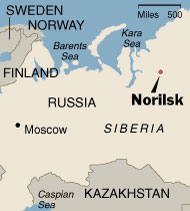
Source: www.thenytimes.com
A key component of analyzing these policies and their effects on these four tribes is to consider the sustainability of these policies with regards to both the environment and the tribes’ traditional ways of life. I would like to clarify that I am defining sustainability as “long-term cultural, economic and environmental health and vitality….together with the importance of linking our social, financial and environmental well-being.” This definition comes from the organization Sustainable Seattle.[1] I argue that Soviet policy towards the indigenous tribes of Siberia in the twentieth century did not promote long-term cultural, economic or environmental vitality, and were therefore unsustainable and unsupportive for the indigenous clans of the region.
Below is a map showing the location of Evenk, Dolgan, Nenet and Nganasan territory relative to Noril’sk and to each other:
The map above shows that Noril’sk serves as a sort of epicenter for these four groups: the Dolgans, Nenets, Nganasans, and Evenks. To learn more about a specific group please click the hyperlinks for further reading. Not only are these four clans close in proximity, but also—like many Siberian tribes—each clan has historically depended on reindeer hunting or herding for their economic livelihood. This does not mean these groups are all the same; they descend from different Eurasian or East Asian ethnic groups and each speak their own native language, among other differences. That being said, each clan experienced similar difficulties adjusting their traditional lifestyles during collectivization and industrialization. There are many ways in which the Soviet Union altered the lives of tribal people in Siberia; collectivization and industrialization are simply the two policies I have chosen to analyze.
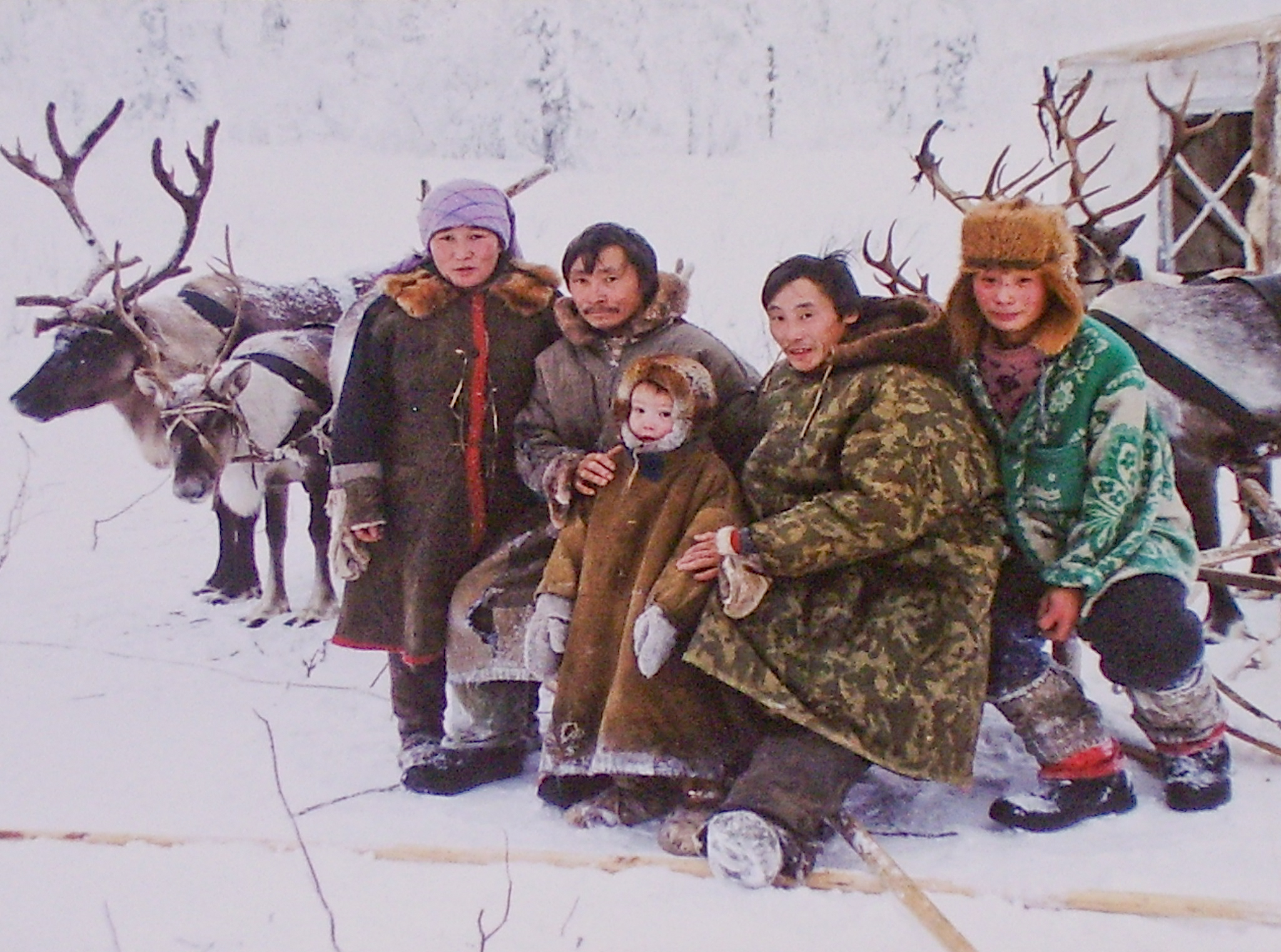
A herding family in northern Siberia. Source: sv.wikipedia.org
Before I begin my overview of Soviet policy, I want to make a note on the complexities of studying the tribes of Siberia and how I have chosen to approach my research. There are upwards of twenty distinct tribes spread throughout the vast geographical area of Siberia. Groups like the Evenks originated from a single region and have since splintered into separate factions and migrated across the continent. These factions developed differences to the extent where it is no longer useful to call them by the same name, yet they are all labeled as Evenk. In other instances Russian officials combined multiple indigenous groups into one category, making it difficult for historians to properly research the groups and draw accurate conclusions—the Dolgans are one such example. [2] The tribes on which I am focusing are all nuanced; the geographical area that they each inhabit stretches beyond the region of Noril’sk, and it would be illogical to present my research as though it outlines the experience of the tribes people in every area of their territory. My research relates to the portions of the Dolgan, Evenk, Nganasan and Nenet tribes that inhabit the areas immediately surrounding the industrial city of Noril’sk.
Pre-Soviet Policies in Nineteenth Century
Under the tzarist regime in the nineteenth century the indigenous tribes in Siberia were allowed to develop mostly uninhibited, due largely to what historian Frances Svensson has named policy space. Policy space is the “spatial, temporal and even intellectual insulation between the objective of policy (such as assimilation) and the subjects of policy.” [3] Policy space exists when the policy makers promote tolerance towards the targeted group and flexible implementation of the policy—in other words, it results in more sustainable policy. In order to better understand how the Soviet policy altered the lives of natives, it is useful to understand the previous government’s policies towards Siberian tribes in general. The tzarist administration passed the Native Code of 1822 that allowed for internal autonomy for the tribal communities and recognized a tribe’s own leader and customary law as the legitimate representative and regulations for the group. Trade was protected and the government took measures to ensure that native laborers were not exploited; taxes were proportional to what the tribes were able to pay. These ordinances were not always implemented properly but the fact that the Code existed at all was significant for the development of indigenous peoples.[4]
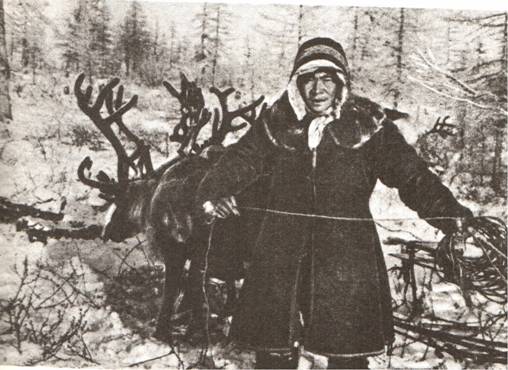
Dolgan Reindeer Herder
Source: Public Domain, www.commons.wikimedia.com
Soviet Policies in 20th Century
In contrast to the policies of the nineteenth century, Soviet policies of collectivization, restructuring, and industrialization put the clans’ identities and economic livelihoods in jeopardy. The party spent some energy focusing on the natives directly, but it was their national policies that had a more severe effect on them. Svensson cites several reasons as to why the Soviets cared about the Siberian tribes, but most importantly, Stalin believed that the Soviet’s communist policies would be of such benefit to the backwards tribes that they could be used as an example in Soviet propaganda.[5] The government set out to reorganize, re-educate and re-introduce the native tribes into modern society—whether or not it was in their best interest.
The late-1920’s and early-1930s saw the infamous Soviet policy of collectivization, which required tribes to give up certain aspects of their nomadic lifestyle and change the nature of societal roles. The goal of policy makers was to phase out the clan structure in exchange for the new Soviet societal order. They believed that native economies that diversified their activities were inefficient.[6] Groups that undertook breeding and hunting, or breeding and fishing together were not maximizing their resources, and so policy makers believed collectivization would rectify that. The enforcers of collectivization organized special brigades within the clans that would focus on one source of income, i.e. hunting, fishing or breeding, but not multiple sources. As part of this endeavor, the state collectivized the natives’ personal property, including tents, sleds, traps and guns. The Party claimed that this reorganization of the rural people would not only create a more efficient system, but also solve problems with administering state goods such as education and health care. [7]
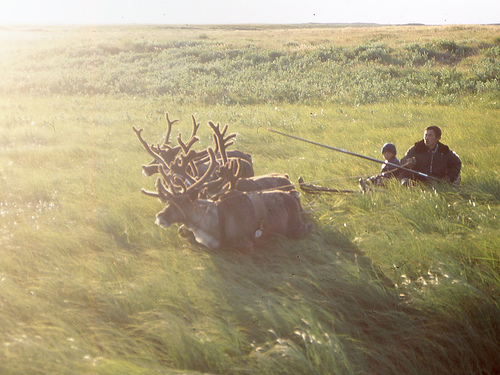
Nenet herders in the summer. Source: Karen Mulders, Flickr
This was a drastic departure from their traditional way of life because it brought about a new division of labor. Tribesmen and women were accustomed to independent lifestyles in which they used their personal tools to hunt their own food for themselves and their families.[8] Collectivization also hindered their nomadic tendencies; this something the Soviets claimed would help civilize them, particularly the women who would be able to stay in a central location and perform daily tasks.
Collectivization had a serious negative impact on the population of reindeer in Taimyr area. A census completed in the late 1920s of various kolkhozes put the number of reindeer head at 41,000 for a kolkhoz in the Nenet ethno-economic area.[9] A similar census in 1961 showed numbers between 19,000 and 24,000 reindeer head at kolkhozes across the Nenet area. [10] For the Nganasan clan, wild reindeer hunting traditionally made up a large portion of their economic income. The same 1926 Polar Census reported that 39% of income came from hunting wild reindeer, 31% came from reindeer breeding, and 22% from fox hunting.[11] By 1956, 87% of income came from reindeer breeding, a clear break from their historic tendencies.[12] These policies forced native tribes to adjust their lifestyles and reprioritize their economic endeavors so that they better fit into the Soviet plan.
It was not until the 1960s and 70s that the government realized the negative effects of collectivization on reindeer herders and they began to rectify the population decline with subsidies. The Dolgan tribe had historically earned most of its income from fur trapping, however collectivization forced them to switch to reindeer herding. They experienced the same types of population decline until the introduction of subsidies in the 1960s. This change came at the same time that many kolkhozes were turned into sovkhozes, or state-run reindeer herding brigades. [13] These subsidies helped to repopulate the reindeer herds and increase the economic gains of these brigades. For example, the Dolgan people saw a 10% increase in income from reindeer herding throughout the 1960s.[14] This was only attainable due to the government subsidies; the experience of the Dolgans was much different at the beginning of collectivization in the 1930s because this subsidy practice was not in place.
Below is a chart showing the rise and fall of the reindeer population for the Evenks, Nenets, Dolgans and Nganasans. Note the decline in numbers in the 1940s, continuing the downward trend from the 1930s following collectivization. Notice as well the continual negative slope of the Nganasan reindeer population, and the increase in population for the Nenets and Dolgans during the period that subsidizing began.
Collectivization affected the Dolgan, Nenet, Nganansan and Evenk tribes to a similar extent as it did all Siberian tribes, however the push for industrialization and the construction of the Noril’sk Mining and Metallurgical Combine plant perturbed their daily life in a very specific, localized way. The Noril’sk plant project began in 1935 in accordance with the Soviet Union’s emphasis on rapid industrialization. The building of the infrastructure for industrial activity, the lines of communication, and the use of off-road transportation began affecting the daily lives of the natives in the area before the plant was even operational. On average, Noril’sk has released thirty tons of metallic dust and heavy metal oxides annually since it began production in the late 1930s.[15] The extent of this pollution spreads 35 kilometers to the northwest, into the territory of the Nenets, and 55 kilometers to the southeast, the territory of the Evenks.[16] By 1997, the year Klokov published his article “Contemporary Problems of Reindeer Husbandry,” it was estimated that the combine has damaged 7.4 million hectares of land in the area surrounding Noril’sk. This damage includes dead trees, damaged shrubs and bushes, and a serious diminishment of lichen cover.
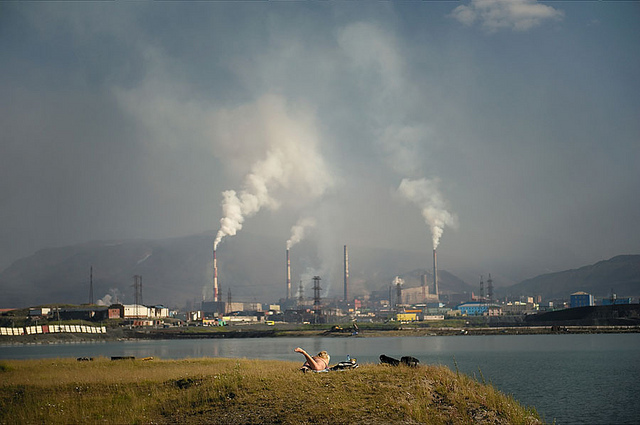
The City of Noril’sk Source: Elenachere
This environmental damage affects reindeer herding in several ways, all of which impede the overall economic success of tribes’ herding endeavors. The direct damage to the environment clearly creates a toxic environment for both the people and the reindeer on which the people rely for income. The lack of lichen cover meant a decrease in food supply for the herds, and that, combined with the new industrial structures, forced a change in migration patterns.[17] This meant that established villages and outposts were no longer located on these migration routes, causing problems particularly in Evenk territory.[18] Nganasan herders that typically brought their reindeer to the west coast of Taimyr in the warmer weather had to look elsewhere for summer grazing locations.[19] This change brought them in close proximity to another northern tribe, the Enets, and this type of proximity was unprecedented.
The two policies interacted in an interesting and contradictory way. The policy of collectivization was shocking to the tribes and the herds, resulting in a lower head count in the initial decades following policy implementation. Meanwhile, industrialization created new centers of population in which the demand for meat was high, yet the reindeer population was shrinking. Moreover, the reindeer herds that were in the area around Noril’sk were often too contaminated with pollution from the combine for the workers of Noril’sk to consume the meat.[20] Needless to say, it was a very confusing and transitory period for the region and the native peoples that inhabited it.
There have been several studies conducted on the adaptation strategies of the groups surrounding Noril’sk. One focuses on the Evenk tribe in particular, and concludes that for the Evenks it is important to maintain as much of their traditional independence as possible; this is only a viable strategy, however, if they allow for a certain level of incorporation into the new industrial society.[21] A survey conducted among the Nenets in the Noril’sk region revealed that although the effects of industrialization have impacted their lifestyle, their land is too central to their belief system to pick up and move elsewhere.[22] Both of these tribal responses demonstrate just how precarious their situation became as a result of Soviet policy. It was nearly impossible to survive without adapting somewhat to the new modern nation the Soviets were attempting to build, but in exchange the Dolgan, Nenet, Nganasan and Evenk had to sacrifice aspects of their traditional culture. In this way, the Soviet policies proved unsustainable for these indigenous groups.
[2] David Anderson, Identity and Ecology in Arctic Siberia: The Number One Reindeer Brigade (Oxford: Oxford University Press, 2000), 82.
[3] Frances Svensson, “The Final Crisis of Tribalism: Comparative Ethnic Policy on the American and Russian Frontiers,” Ethnic and Racial Studies, 1 (1978): 101.
[4] Ibid, 108.
[5] Svensson, “Final Crisis of Tribalism,” 111.
[6] Yuri Slezkine, Arctic Mirrors: Russia and the Small Peoples of the North, Cornell UniversityPress, 1994: 204.
[9] Konstantin B. Klokov, “Northern Reindeer of Taymyr Okrug as the Focus of EconomicActivity: Contemporary Problems of Reindeer Husbandry and the Wild Reindeer Hunt,” Polar Geography 4 (1997): 238.
[10] Ibid, 238.
[11] Ibid, 239.
[12] Ibid, 239.
[13] Konstantin B. Klokov, “Changes in Reindeer Population Numbers in Russia: An Effect of the Political Context or of Climate?” Rangifer 32 (2012): 24.
[14] Klokov, “Contemporary Problems of Reindeer Husbandry,” 245.
[15] Ibid, 248.
[16] Klokov, “Contemporary Problems of Reindeer Husbandry,” 248.
[17] Anderson, Identity and Ecology in Arctic Siberia: The Number One Reindeer, 62.
[18] Ibid, 62.
[19] James Forsyth, A History of the Peoples of Siberia: Russia’s North Asian Colony 1581-1990, Cambridge University Press, 1994: 311.
[20] Klokov, “Contemporary Problems of Reindeer Husbandry,” 247.
[21] D. V. Vorob’ev, “Subsistence and Adaptive Strategies among the Evenki in the Late Twentieth Century,” Anthropology & Archeology of Eurasia 43 (2004): 40.

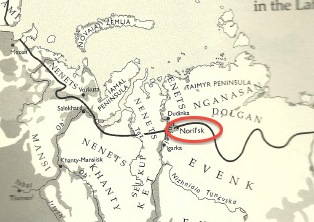


You mention the environmental impact of the Mining Combine in Noril’sk on the economics of the rural groups, but what of the tribes’ cultures? In some instances, rural workers and farmers moved to urban centers as employment was better in the cities than in the countryside. Was there any such movement regarding these tribes? It would be interesting to see if their culture was assimilated into city culture or if they were ultimately “modernized” by city life and disconnected from their rural roots.
How did collectivization differ for nomadic tribes and the inhabitants of Noril’sk?
While you illuminate on several aspects of the negative aspects of collectivization, could you elaborate more on the effects of industrialization on the nomadic tribes?
I would have to both disagree and agree with Brandon Golob on this argument because even though they will be around new people and different ways of life there roots are still very deep engraved in there history and I could not see them changing and still sticking with there ways of life.
@ZiegZag4 I would have to concur about your last post about Siberian culture venturing out from their past rural roots and becoming more modern. We can see this by impact of other modern day people and their views and different ways other than rural roots. Modern day technology also supports this idea. Even though their will still be some roots that will stay with them forever.
I would have to both agree and disagree with you Brandon. yes advancements with new technology will make them seem more modern, but they still have the same ways as they did in the past. for instance, they still treat furs as a way of their life. they are strong people who developed a way of life that will never go away
I would very like to see the effect on the big city people on the Indigenous Tribes. I feel that there would be a big difference in the tribes and that they would start conforming to the many new ways and values compared to there own. It would be hard not for them to change there ways because of the pressure of the modern society.
@Charlie Marks. I would have to disagree with some parts of your arguments. The Indigenous Tribes will not change there ways because of how in deeply rooted there ways are.